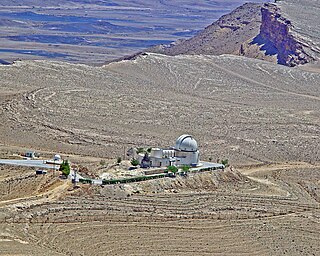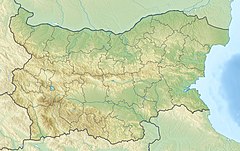
Stardome Observatory is a public astronomical observatory situated in Maungakiekie/One Tree Hill Domain in Auckland, New Zealand.

The Florence and George Wise Observatory is an astronomical observatory owned and operated by Tel Aviv University. It is located 5 kilometers west of the town of Mitzpe Ramon in the Negev desert near the edge of the Ramon Crater, and it is the only professional astronomical observatory in Israel.

The Kodaikanal Solar Observatory is a solar observatory owned and operated by the Indian Institute of Astrophysics. It is on the southern tip of the Palani Hills 4 kilometres (2.5 mi) from Kodaikanal.

The Vainu Bappu Observatory is an astronomical observatory owned and operated by the Indian Institute of Astrophysics. It is located at Kavalur in the Javadi Hills, near Vaniyambadi in Tirupathur district in the Indian state of Tamil Nadu. It is 200 km south-west of Chennai and 175 km south-east of Bangalore.

Konkoly Observatory is an astronomical observatory located in Budapest, Hungary is part of the Research Centre for Astronomy and Earth Sciences and belongs to the HUN-REN Magyar Kutatási Hálózat. Konkoly Observatory was founded in 1871 by Hungarian astronomer Miklós Konkoly-Thege (1842–1916) as a private observatory, and was donated to the state in 1899. Konkoly Observatory, officially known as HUN-REN CSFK Konkoly Thege Miklós Csillagászati Intézet in Hungarian, is the largest astronomical research institute in Hungary, and hosts the largest telescopes in the country. The Observatory has more than 60 researchers, a quarter of them are non-Hungarian.

The Institute of Astronomy of Nicolaus Copernicus University in Toruń, known prior to 1 October 2019 in scientific publications as the Toruń Centre for Astronomy, is an optical and radio observatory located at in Piwnice, about 15 km north of Toruń, Poland. It houses two single-dish antenna telescopes, 32 metres and 15 metres in diameter, as well as the largest Polish optical telescope – 90 cm Schmidt-Cassegrain camera. The facility is operated by the Nicolaus Copernicus University. Also, photometry using 60 cm Cassegrain telescope is made and radio measurements of the Sun at 127 MHz frequency have been recorded on a daily basis since 1958 using a 23 m interferometer.

Rozhen Observatory, also known as the Bulgarian National Astronomical Observatory, is an astronomical observatory, located in the Smolyan Province, 90 kilometers south of the city of Plovdiv, Bulgaria. The nearest town, Chepelare, is 15 kilometers away. The observatory is owned and operated by the Institute of Astronomy of the Bulgarian Academy of Sciences (BAS). It was officially opened on 13 March 1981, almost 20 years after Bogomil Kovachev – a professor of astronomy at BAS, known as its founder – had started working towards that goal. The Observatory is the largest in Southeastern Europe and has an active team of about 50 astronomers. It is the principal center for astronomical research in Bulgaria. The minor planet 6267 Rozhen, was discovered at, and named after the observatory.
The Institute of Astronomy of the Bulgarian Academy of Sciences is a leading Bulgarian research facility in the field of astronomy and astrophysics, located in Sofia, Bulgaria.

The Shamakhy Astrophysical Observatory, named after Nasreddin Tusi of the National Academy of Sciences of Azerbaijan was established on November 17, 1959, by decree No. 975 of the Council of Ministers of the Azerbaijan SSR. ShAO operates as a research institute within the ANAS Department of Physical, Mathematical, and Technical Sciences. The Observatory is located in the north-east of the Greater Caucasus Range, 150 km from the city of Baku, in the eastern part of Mount Pirkuli, at an altitude of 1435–1500 m above sea level, in geographical coordinates λ = 48⁰ 35' 04" E, φ = 40⁰ 46 '20"N. Here the number of clear nights suitable for observation reaches 150-180 per year.

The Givatayim Observatory is a public observatory that was founded in 1968 by the Israeli Astronomical Association and the Givatayim municipality.

IUCAA Girawali Observatory is an optical astronomy observatory run by the Inter-University Centre for Astronomy and Astrophysics (IUCAA), Pune, India. The Observatory is located about 80 km from Pune, off the Pune Nashik Highway in Girawali.
The Canopus Hill Observatory, located approximately 12 km from Hobart in Tasmania, Australia, is an optical astronomy observatory belonging to the University of Tasmania (UTAS). Due to the high southern latitude, the Canopus Hill Observatory is able to observe and study the Magellanic Clouds. However, the observatory has closed down due to the "encroaching light pollution from the Hobart suburbs". According to the Astronomical Society, light pollution reduces the vision of the night sky, becoming a "major menace to amateur and professional astronomers alike".

Bayfordbury Observatory is the University of Hertfordshire's astronomical and atmospheric physics remote sensing observatory, and one of the largest teaching observatories in the UK. It is located in the relatively dark countryside of Bayfordbury, Hertfordshire, 6 miles from the main university campus in Hatfield. The first telescope was built in 1969, and since then has been used as a teaching observatory for undergraduate students, staff and student research as well as for public outreach activities.

The ÇOMÜ Ulupınar Observatory (UPO) is a ground-based astronomical observatory, which was established in 2001 and formally opened on 19 May 2002. It is also known as Çanakkale Observatory or the University Observatory. The Ulupınar Observatory is part of the Çanakkale Onsekiz Mart University (ÇOMÜ) Faculty of Science and Arts.

The Ankara University Observatory (AUG), is a ground-based astronomical observatory operated by the Astronomy and Space Sciences Department at Ankara University's Faculty of Science. Established in 1959 by Dutch astronomer Egbert Adriaan Kreiken in Ahlatlıbel, Ankara. Currently, it consists of nine optical telescopes and a radio telescope, which is currently taken out of service. Old instruments are displayed in a museum at the observatory.

The Ege University Observatory is a ground-based astronomical observatory operated by the Astronomy and Space Sciences Department at Ege University's Faculty of Science. Formally opened on June 22, 1965, it is located in Kurudağ at Buca district, 10 km (6.2 mi) east of Izmir in western Turkey. The telescope domes of the observatory are situated at an altitude of 800 m (2,600 ft) while the main building is erected at 632 m (2,073 ft).
The Ondokuz Mayıs University Observatory is a ground-based astronomical observatory operated by the Astronomy and Space Sciences Department at Ondokuz Mayıs University's Faculty of Science. Established on June 1, 2006, it is located within the university campus at a distance of 14 km (8.7 mi) north-west of Samsun, northern Turkey. It is one of the six university observatories in the country.

The Tien Shan Astronomical Observatory is an astronomical observatory located in the Tien Shan Mountains at 2,800 meters altitude, 30 kilometers south of the city of Almaty in Kazakhstan. It was assigned to the Sternberg Astronomical Institute (GAISh) until the collapse of the Soviet Union. The observatory is a state-owned scientific institution that belongs to the Astrophysical Institute after V.G. Fesenkov. It is often used for photometric investigations of variable stars in the Milky Way, eclipsing systems.

The Yapp telescope is a 36-inch reflecting telescope of the United Kingdom, now located at the Observatory Science Centre at Herstmonceux.
The Hvar Observatory, part of the Geodetic school of the University of Zagreb, is an astronomical research observatory located above the city of Hvar. Opened in 1972, research at the observatory focuses on solar physics; the photometry of stars, especially variable class Be stars; and star clusters and galaxies. A double telescope is used for solar observation: one telescope observes the photosphere and the other observes the chromosphere with a narrowband spectral filter. For stellar observation, a Cassegrain reflector with an opening diameter of 65 cm is used. Since 1997 a shared Austro-Croatian telescope is also used for stellar observation, which has a mirror diameter of 1 m and is also a Cassegrain reflector.
















